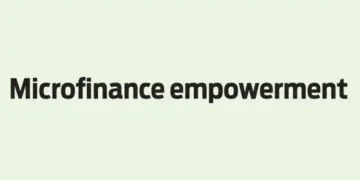 INITIALLY conceived as a way to alleviate poverty and to empower women, microfinance has expanded significantly over the past 10 years. Presently, the sector plays a critical role in extending financial services to the unbanked and underbanked, particularly in rural areas. With a loan portfolio of more than Rs. 42 lakh crore as of September 2024, and a customer base of eight crore, the microfinancing institutions (MFIs) have made significant contribution to the empowerment of people.
INITIALLY conceived as a way to alleviate poverty and to empower women, microfinance has expanded significantly over the past 10 years. Presently, the sector plays a critical role in extending financial services to the unbanked and underbanked, particularly in rural areas. With a loan portfolio of more than Rs. 42 lakh crore as of September 2024, and a customer base of eight crore, the microfinancing institutions (MFIs) have made significant contribution to the empowerment of people.
Indian microfinance space has evolved to include different players like Small Finance Banks (SFBs), Non-Banking Financial Corporation-Microfinance Institutions (NBFC-MFIs), banks, and not-for-profit MFIs. Apart from the non-profits, the rest of these actors are all regulated by the Reserve Bank of India. On the other hand, most non-profits are registered as trusts or societies and are, therefore, regulated by the corresponding laws. This variety points to an organised and corporatised approach to microfinance.
The RBI has periodically enforced regulations to simplify microfinance operations and guarantee customer protection. The 2010 microfinance crisis in Andhra Pradesh led the RBI to institute Malegam Committee to scrutinise issues and concerns in the sector. The committee’s recommendations led to the creation of a comprehensive regulatory framework for NBFC-MFIs, including interest rate caps, margin caps, and guidelines on fair practices.
In 2014, the RBI recognised the Microfinance Institutions Network (MFIN) and Sa-Dhan as Self-Regulatory Organisations, which play a crucial role in ensuring regulatory compliance and promoting best practices. More recently, in 2022, the RBI introduced harmonised regulations for all regulated entities involved in microfinance, aimed at creating a level-playing field, addressing issues of over-indebtedness, and ensuring transparent pricing and fair practices. The RBI has also pushed for data localisation, caps on multiple lending, and maintenance of public credit registries.
The adoption of new technologies has proved transformational. Digital platforms have decreased operating expenses and turnaround times, making microfinance more efficient and scalable. MFIs are now able to process loan applications, disbursements, and repayments online, reducing the requirement for physical branches and enhancing reach to remote regions. Mobile phones have also emerged as critical instruments of financial inclusion. Using mobile banking and payment applications, MFIs can reach customers in rural and underserved areas, enabling simpler and faster transactions.
Finally, Government programmes have also significantly boosted India’s microfinance sector. A major contribution of Government initiatives has been to direct credit extension to underserved segments through priority sector lending, Micro Units Development and Refinance Agency (MUDRA) Yojana, loan co-origination and private investments. To supplement these, measures are being taken to empower women by extending credit to them on easier terms, supporting them in establishing businesses and involving them in financial literacy programmes. Initiatives such as the Pradhan Mantri Mahila Shakti Kendra are anticipated to create a supportive environment for women to realise their complete potential The microfinance sector has grown due to regulatory reforms, technological advancements, and Government initiatives, extending credit to millions of previously underserved households. Despite these positives, there are areas of concern. A vital support system for low-income households, MFIs are facing challenges that are hindering their ability to serve the underserved population. Rising bad loans and borrower over-leveraging are impacting these companies, with an increase in the number of borrowers holding more than four loans from different lenders.
































